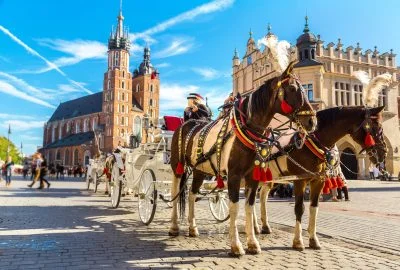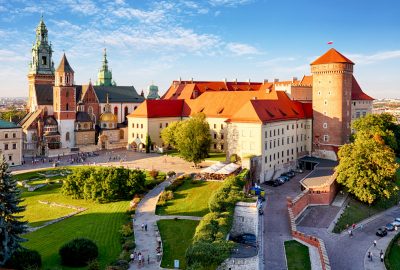Kraków (Cracow) is the first thing that comes to mind when people are asked about Poland, or third, after kielbasa and vodka. All right, fourth or even fifth since I almost forgot about pierogis…and Lech Walesa. Kraków is beautiful, full of historic sights, legends and royal atmosphere. It used to be the Polish capital and for good reason, the iconic Wawel Castle for example with its mausoleum of ancient monarchs and latest, debatable additions. That hill is also where the dragon of legend lives, supposedly still feasting on virgin girls. In fact, he lost a bit of weight, since that kind of a diet is hardly sustainable nowadays. Kraków was lucky; it remained untouched by the bombardments, the Old Town (Stare Miasto) and the Main Market Square (Rynek Główny) are the same as they were during medieval times. St. Mary’s Church, overlooking the square, is a textbook example of Polish gothic architecture with Wit Stwosz’s iconic wooden altar and a trumpeter playing the Hejnał at noon every single day from his tower. That tradition began during the Mongol invasions back in the 13th century.

Rynek Główny: the main market square of Kraków was built in 1257 and ranks amongst the largest and without doubt most beautiful squares in Europe; it's the central hub of historical, cultural and touristical life in Kraków
Kazimierz lies just outside of the old town. It used to be a separate city populated by Jews, which eventually became a part of Kraków itself. Now it’s a living and breathing museum of Jewish culture, but also the hipster central with bars and restaurants around every corner. Back in 1993, for his movie Schindler's List Stephen Spielberg needed a venue to depict the Jewish ghetto of Podgorze in Kraków where the factory of Oskar Schindler was located. Spielberg picked Kazimiers because unlike the Podgorze area it had not been affected since the 40’s. Oskar Schindler has been praised and became world famous for saving almost 1100 Jews from working in a Nazi labour camp by employing them in his factory. Since 2003 Schindler’s Factory district has turned into a popular museum.
Without any doubts the most popular day-trip with Kraków visitors is a visit to Auschwitz-Birkenau, which was the largest of Nazi Germany’s concentration camps, located around 60 kilometres from Kraków. The total number of the people killed in the camp is estimated at the unbelievable number 1.1 million. Be prepared that visiting the huge sites of Auschwitz and Auschwitz 2 (Birkenau) will probably be one of the most impressive and at the same time most depressive experiences you will have in your entire life. There has been created a whole industry around it and witnessing the inevitable side effects of mass-tourism can you make feel sad and awkward as well. At least that happened to me when being there. Most visitors behave respectfully but there are also anecdotes about people making smiley selfies to the backdrop of the “Arbeit mach Frei” gate or making funny poses on the railways, which transported 100,000s of people straight to mass termination.

Wawel Castle: the architectural ensemble on the left bank of the Vistula (Wisła) River in Kraków includes a royal castle, a cathedral and a system of castle fortifications
Another impressive but more cheerful excursion is a visit to the salt mine in Wieliczk, one of the oldest salt mines in the world located around 14 kilometres southeast of Kraków. Over 1 million people per year descend 135 meters deep and wander through a labyrinth of corridors and stairways. The salt lakes, chambers, chapels and statutes, all carved out of white salt since the medieval ages will bring you in awe. It is a unique and almost unreal environment and due to its specific and healthy climate there is even a sanatorium for the treatment of chronic allergic diseases.
You are highly recommend to not to book your excursions to Auschwitz-Birkenau or the Wieliczk salt mine with the fist person or agency that will make you an offer, especially out on the street. Some local travel agencies and independent guides will ask outrageous prices. You could already save a lot of money when you would book online entrance tickets directly on the official sites and/or travel by local public transport when possible. These tourist attractions in Kraków’s neighbourhood, including some based on immensely sad times in history, in combination with the indisputable beauty of the preserved Old Town, have made Kraków of what it is today: one of the most popular travel destinations in Central Europe. Kraków has also become a main bachelor weekend destination of choice; booze is cheap and bars are plenty, girls are stunning and eager to chat with foreigners.



No one commented yet. Be the first.